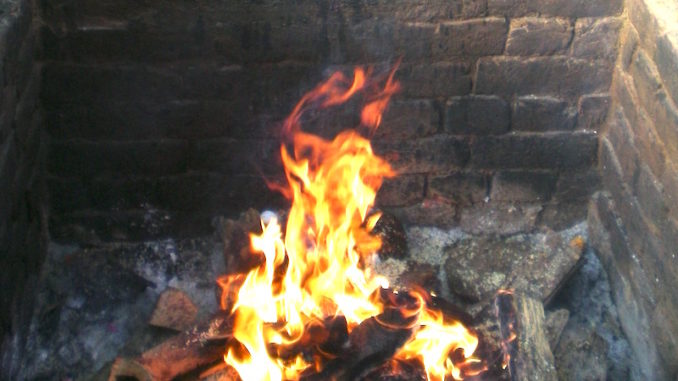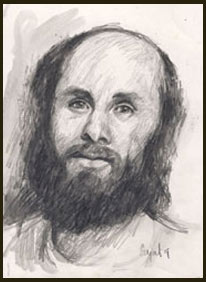
Dr. David Frawley, also known as Pandit Vamadeva Shastri, talks about Atma Yagya, correlating Self Inquiry with Yagya, the fire Sacrifice.
More writings from his website
Self-inquiry (Atma-vichara), such as taught by Bhagavan Ramana Maharshi, is regarded as the simplest and most direct path to Self-realization. However, Self-inquiry is also very subtle and can be hard to accomplish even after years of dedicated practice. It depends upon a great power of concentration and acuity of mind along with an intense longing for liberation. One might say metaphorically that Self-inquiry requires a certain flame. It requires that we ourselves become a flame and that our lives become an offering to it. Without such an inner fire, Self-realization may elude us whatever else we may attempt. Therefore, it is important to look at Self-inquiry not simply as a mental practice but as an energetic movement of consciousness like the rising up of a great fire.
 In this psychological age, particularly seekers coming from the West tend to confuse Self-inquiry with a kind of psychological self-examination, a looking into our temporal, bodily or ego self and its fears and desires as constituting a true search for the higher Self. One examines ones personal traumas and sorrows and looks for a psychological state of peace, clarity and joy, which is a kind state of personal integration, as if it were true Self-realization.
In this psychological age, particularly seekers coming from the West tend to confuse Self-inquiry with a kind of psychological self-examination, a looking into our temporal, bodily or ego self and its fears and desires as constituting a true search for the higher Self. One examines ones personal traumas and sorrows and looks for a psychological state of peace, clarity and joy, which is a kind state of personal integration, as if it were true Self-realization.
However, according to Vedanta, the true Self that we are seeking to realize is not our human self but the universal Self, the Self that is present in all beings, in all bodies and in the entire world. It is the Self that is the witness of all time and space and transcends our psychology, which consists mainly of the incidentals and peculiarities of our personal circumstances and proclivities in life. The true Self resembles more the great powers of nature like fire, wind or sun than it does our personal thoughts and feelings. The search for this transcendent Self is very different than any psychological self-examination, which is at best a preliminary stage in its approach.
Other seekers with a more intellectual background tend to approach the Self in a conceptual or philosophical way, as if it were some category of cosmic existence to be appreciated by the rational mind. This too generally misses the living reality of the Self which has the power to consume the mind and cannot be approached by any mere logic or dialectic.
To question deeply about who we really are is to create a friction at the core of the mind that naturally gives rise to an inner fire. The inquiry ‘Who Am I?’ is the ultimate stirring of the mind that brings forth an inner flame that can consume all other questions and doubts, like a fire burning dry grass. It takes us back to the core fire at the core of the mind, which is the inextinguishable light of the supreme I AM. That universal Self of pure light and consciousness shining deep within us is the real goal of our search.
The Self in the Vedas and Upanishads is often symbolized by fire (Agni). The Rig Veda begins with the worship of Agni, who is the deity of the sacrifice. But who is this Agni and what is the nature of the sacrifice to be offered to it?
There are many forms of Agni in Vedic thought. Agni outwardly as fire and light and inwardly as life and consciousness pervades all things in the universe. In the Vedic view, Agni has three main cosmic (adhidaivic) or world forms as fire, lightning and sun which are the ruling forces in the three worlds of earth, atmosphere and heaven. These are the three lights in the world of nature and the three manifestations of Paramatman, the Supreme Self that is the Divine Light and the light of all the worlds.
In addition, Agni has three main internal (adhyatmic) forms as speech (vak), prana and intelligence (buddhi), which are the ruling forces in the three aspects of our being as body, life and mind. They are the three lights of our internal nature and the three manifestations of the Soul or Jivatman, the consciousness or light principle within us.
These three internal forms of Agni create the three main paths of Yoga practice. Agni’s speech form is the basis of Mantra Yoga or the repetition of sacred sounds like OM or longer prayers like the Gayatri mantra. Mantra practice creates an internal fire that helps purify the subconscious mind and make the mind receptive to meditation. Agni’s prana form is the basis of Prana Yoga or yogic breathing practices of pranayama. Pranayama increases the fire of prana (Pranagni) within us that cleanses the nadis of the subtle body and helps unloosen the knots or granthis of the heart. Agni’s mind form is the basis of Dhyana Yoga or the yoga of meditation. The mind form of Agni or the buddhi is the discriminating part of the mind that allows us to distinguish truth from falsehood, reality from unreality and the Self from the not Self. These three forms of Agni and their related yogic paths take us to the Jivatman or our individual Self and help us understand its basis in the Paramatman or Supreme Self.
There are many Vedic yajnas or fire-sacrifices both external and internal. External yajnas consist of offerings of special substances of wood, ghee, milk or rice into the sacred fire. Internal yajnas consist of offerings of speech (mantra), breath (prana), and mind (meditation) into our internal fires. Vedic Yoga practices of mantra, pranayama and meditation are the main internal yajnas. Yoga itself is the inner sacrifice in all of its forms. The fourth chapter of the Bhagavad Gita explains these different internal sacrifices which reflect the different practices of Yoga including pranayama (Prana-yajna), pratyahara (Indriya-yajna), dharana (Mano-yajna) and dhyana (Buddhi-yajna). Each relates to a different form or aspect of Agni on the levels of body, breath and mind.
The highest Yajna is the Atma-Yajna or Self-sacrifice in which we offer the ego into the Self. This is the also the highest form of meditation or the mind-sacrifice, as the ego is the root of the mind. For this Yajna, the Agni is the Atman or true Self. Self-inquiry is perhaps the ultimate form of this Atma-Yajna or Self-sacrifice, in which the ego can be directly consumed. It is also called the knowledge-sacrifice (Jnana-yajna) that proceeds through the power of the fire of Self-knowledge (Jnanagni)
In this Self-sacrifice, the Self is not only the offering; the Self is the offerer and the fire in which the offering is given. In this regard we are reminded of the words of the Gita:
“Brahman is the process of offering. Brahman is the substance offered. Brahman is the offerer, who places the offering into the fire of Brahman. Brahman alone is attained by this action of absorption in Brahman.”
If we look at Self-inquiry as a Self-sacrifice or Atma-yajna, we gain a new perspective to take our practice to a deeper level beyond the complications of the outer mind.
Self-inquiry is a lot like cultivating a fire. Our awareness grows by offering our speech, breath and mind into the witnessing Self that is the eternal and inextinguishable flame within us. It is the quality and consistency of our offering that is the main factor in growing this flame, not any outer formulas or formalities. We must maintain our awareness like a fire, keeping it from going out even for an instant by continually offering our mental modifications into it as its fuel. Indeed we could say that the modifications of the mind are nothing but the smoke coming forth from an improperly burning fire of awareness. When that inner flame burns cleans and consistently then there is only pure light and the mind itself gets merged in its source.
For Self-inquiry to be a living process we must invoke and incarnate that inner flame of knowing in our daily lives. Self-inquiry is not a matter of ordinary thinking or logic. It is not a matter of emotion or feeling either. It is not a matter of just blanking or stopping the mind as it is. Nor is it some esoteric intuition. It is the most fundamental form of knowledge, perception or consciousness that we have. It is cultivating the pure light behind all the glitter and shadow of the mind and senses. The Self is the mind behind the mind, the eye behind the eye, the speech behind speech and the prana behind prana as the Upanishads so eloquently state.
Behind all of our senses through which we perceive the external world is a more primary internal sense of self-being through which we know that we exist and through which we are one with all existence. This self-sense is more immediate than all the outer senses which are only possible through it. But it is so immediate and given, our very sense of being, that we take it for granted and ignore it. In the maze of sensory information we lose track of who we really are. We get caught in the movements of the body and the mind and forget our true nature that transcends them and for which alone they work.
We must remember this very subtle inner fire through which the mind and senses shine and reveal their objects of perception. Cultivating this direct awareness of the Self (aparoksha anubhava of Vedanta) is a lot like conducting a fire sacrifice. Behind all of our states of mind, even the most ignorant or confused, like a flame hidden in darkness, the Self shines as the eternal witness of all. What is important is to bring that flame out, like a fire hidden in wood, through the friction of inquiry.

Leave a Reply